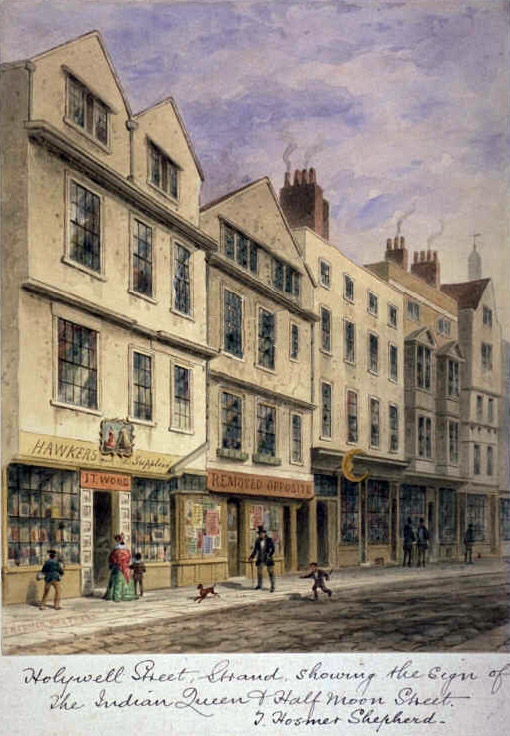‘Like a festering wound covered by cloth’: cleaning, cutting and curing the Strand
Posted in 1920-1929, Retail, shops, Strands, streets and roads and tagged with Aldwych, Booksellers Row, E. Beresford Chancellor, John Gay, Kingsway, Trivia
Today I stumbled across a strand story written by E. Beresford Chancellor in 1927. It is from his ‘Introduction’ to Disappearing London (ed. Geoffrey Holme, London: The Studio Limited, 44, Leicester Square).
‘[T]here is beginning to spring up a generation which remembers, but cannot for the life of it recall, the Strand and its northern purlieus as they were before the Aldwych curve and the Kingsway boulevard swept out of existence Holywell Street and Wych Street and the slums that lay behind them, filthy and fetid with the accumulated dirt and squalour of the centuries. We may, as I for one do, regret the disappearance of those twin streets which bore their antique air with something of a quiet distinction. They were not over-cleanly; they were narrow; and, in view of our Juggernautish traffic they were impossibly inconvenient. But what ghosts you saw (in the mind’s eye) passing along them! what memories they evoked! what pleasures along them – the Booksellers Row of so many bargains – they afforded! They were the only two thoroughfares in all London which alone seemed to me to recall Gay’s “Trivia.” For in them all the déségremens and not a few of the joys, of walking the streets, as the poet depicts them, could be imagined, and some of both realized. Well, they are gone, and with them are gone so much that required removal; so much which, decorative as it was in retrospect, was in reality an unwholesome area, hidden from the busy Strand, but always there – like a festering wound covered by cloth. When that great improvement (even those who care for old landmarks cannot, I think, deny that it was one) took place, it was done thoroughly. Not merely were new and splendid streets run through the district, but all the low and squalid surroundings were cleared away. And parenthetically I may remark that this has nearly always been our custom as differentiated from that of Paris (to take an instance where much re-building has occurred) where when a new boulevard or street is laid out, it cuts through the area like a knife, leaving cheek by jowl with it all sorts of ancient and uncleanly little by-streets; so that immediately off the great flaring Boulevard Sebastopol we have the Rue Quencampoiz essentially as it was in the seventeenth century, and the Rue des Lombards which dates from the thirteenth.’

Holywell Street by Thomas Hosmer Shepherd, 1864. Via Wikimedia Commons.

